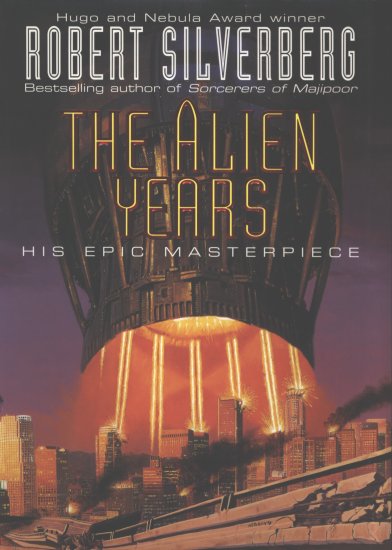The Alien Years
- Form
- Novel
- Year
- 1997
Publication history
- 1998: The Alien Years, Harper & Row Hard cover book, 428 pp.
- 1998: The Alien Years, Voyager Hard cover book, 453 pp.
- 1998: The Alien Years, Science Fiction Book Club Hard cover book, 428 pp.
- 1999: The Alien Years, Harper & Row Mass market paperback, 488 pp.
- 1999: The Alien Years, Voyager Mass market paperback, 453 pp.
- 2000: Le Grand silence, Flammarion Mass market paperback, 435 pp., in French as Le Grand silence
- 2000: Die Jahre der Aliens, Heyne Mass market paperback, 590 pp., in German
- 2002: Le Grand silence, J'ai lu Mass market paperback, 573 pp., in French as Le Grand silence
Blurb
(From Harper & Row 1998)It was the worst of times. Period.
The Entities came, quite literally, out of nowhere, landing in cities all across our Earth: Los Angeles, London, New York, Beijing. Fifteen feet tall and indescribably beautiful—or unbelievably hideous, depending on your point of view—the alien invaders treated humankind in the worst way imaginable.
They ignored us. They made no attempt to communicate with us. They wanted nothing from us. Walling themselves in impenetrable enclaves, enslaving a few willing collaborators with their telepathic PUSH, they casually plunged the rest of the Earth into a new Dark Age without electricity. Communications, governments, banking systems—all evaporated like smoke; anarchy reigned. Our few pathetic attempts at fighting back resulted in murderous plagues and mass executions, quickly convincing us that resistance was futile. The Entities' silent message was clear: We were allowed to live, but no longer as a dominant species.
But a few refused to believe. A few held out hope. Among them were the Carmichaels: a far-flung family of aviators, soldiers, misfits, hustlers, and hackers. As the world darkened into chaos around them, they gathered in their enclave in the hills of Santa Barbara, led by a patriarchal colonel who had learned to hate war in Vietnam and found himself devoting his life, and the lives of his descendents, to keeping the idea of resistance alive. The colonel's legacy is carried on by an unlikely team: an aging hippie, a cold-blooded Muslim assassin, a prodigal son, and a renegade hacker all united in spirit, who will penetrate the inner halls of cyberspace to kill the mysterious Prime Entity and free the planet the rest of us have all but forgotten how to love.
Robert Silverberg's vast new masterpiece chronicles half a century of alien occupation, when a family—and humanity itself—rediscovers the courage, the discipline, and the audacity necessary to stand up to an all-powerful and indefferent enemy. Only an accomplished master of science fiction, the author of some fifty novels, could command the literary and scientific expertise to bring life to a world exceedingly strange and yet strangely familiar...
The absolute worst of times.
The Alien Years.
Comments
This novel consists in part of three stories published in Science Fiction Age recently (Beauty in the Night
, On the Inside
, and The Colonel in Autumn
) and a slight reworking of The Pardoner's Tale
, and is a variety of aliens-take-over-the-earth story, a plot Silverberg hasn't done in quite a while.
Some of Silverberg's comments about the book: Aliens arrive one day, setting fire to Los Angeles in the process, and conquer the hell out of us with the greatest of ease. We spend the next hundred fifty years trying to figure out how to cope with the defeat and go on from there. My response to Wells' War of the Worlds... The invaders shut down electricity – nothing works, computers, electric can openers, auto ignition – and we are conquered in a single day... The Alien Years contains three of my old stories embedded in it, joined by common theme of alien invasion.
[As I've mentioned, there are actually at least four stories worked into the book, though it's possible some of these are actually exceprts from the novel, and not precursors. — Jon]
One thing that's a little unusual for Silverberg is that one of the main characters is Colonel Anson Carmichael III, a retired Army man and Vietnam veteran. Silverberg has very seldom dealt with military characters, especially those in the present or near future. (The first section of the book is labeled Seven Years from Now
, a somewhat dangerous tactic for a writer.) The Colonel is a conservative stuffed-shirt type, but (as always) dealt with symapthetically. The choice of Anson for the Colonel's name can hardly be accident – I'm sure Silverberg intended a tribute to the late Robert A(nson) Heinlein, for the Colonel is very like any number of Heinlein patriarchs (and probably Heinlein himself).
It is also notable that although the aliens land in many locations, Silverberg concentrates almost entirely on the LA area, telling the multi-generational story of the Carmichaels. The cover art on both the American and UK editions is misleading: at no point do massive spacecraft hover over cities and fire energy beams downward. The ships are described as being the size of a ten-story building
– big, but hardly Independence Day motherships.
For a more detailed analysis click the link below, but be advised: spoilers abound.
Other online reviews:
